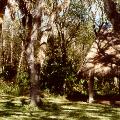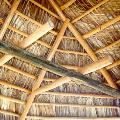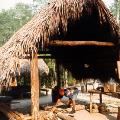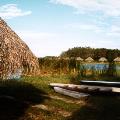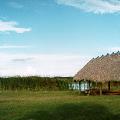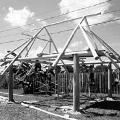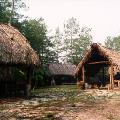Culture
Who We Are
Chickee
"Chickee" is the word Seminoles use for "house." The first Seminoles to live in North Florida are known to have constructed log cabin-type homes, some two stories tall, with sleeping quarters upstairs. The chickee style of architecture - palmetto thatch over a cypress log frame - was born during the early 1800s when Seminole Indians, pursued by U.S. troops, needed fast, disposable shelter while on the run. Though indigenous peoples in other parts of North and South America have developed similar dwellings, it is generally agreed that the Seminole Indian technique and product are far superior.
So popular, efficient and functional is the chickee that such Seminole architecture can be seen all over South Florida. The chickee structure should last about ten years and needs to be re-thatched every five years. Several Seminole Tribal members make a living building custom chickees for both commercial and private interests.
Chickees Provided Early Housing
By Ernie Tiger
In 1821 the lives and homelands of many southern indigenous people were changed forever when U.S. Troops, under the command of Andrew Jackson, were on their pursuit to conquer Florida for its vast riches. In 1830, shortly after this Indian fighter was elected President of the United States, the newly elected Jackson pushed through Congress the Indian Removal Act. The Act would move Indians out of the Southeast and relocate them west of the Mississippi River, thus opening up land for white settlements in the Southeast and pushing the Seminoles further into the Florida interior to seek refuge.
After the Removal Act went into effect the Seminole people were hunted like animals by U.S. troops who were in no mood to give mercy to these innocent people who had lived in peace for many years. With a life of constant fleeing from U.S. troops, housing for the Seminoles had to be drastically changed. They could no longer rely on their more traditional houses which were more stationary and equipped with features such as walls and sleeping quarters. They needed a quicker, easier to put up, disposable shelter while frequently moving to different camps.
A new era of engineered housing evolved for the Seminoles called the "chickee." The chickee was constructed with cypress logs and palm thatch leaves woven together by vines or thin ropes. It had no walls only a thatched roof that covered the area around the upward standing cypress logs submerged shallowly into the earth. After time the Seminoles perfected their housing by adding another level to their chickee making them two stories high with living quarters for those more fortunate.
But after the Indian Wars ended in 1842 and time passed by, the Florida tourism boom started. The once relied on structures became impractical for modern day housing and stucco and brick was introduced for the Tribe's new housing.
Chickees in today's time are now put together in a matter of hours instead of days because of the improvements in technology and equipment used to construct the unique structures. Nails, chainsaws and four wheelers are now used to haul the heavy logs replacing the old method when the Seminoles would either use manpower or wait until a thunderstorm would flood the area were logs had been cut down so they could be hauled out to the location of the new camp.
Nobody really looks to chickees anymore for actual housing, but chickees haven't been forgotten or overlooked. Building chickees has become a big business in Florida in recent years.
The entrepreneurs have looked to this unique structure as a way to make profit from Florida's heritage and preserve the past at the same time so that it's not forgotten.
